|
|
|
Sort Order |
|
|
|
Items / Page
|
|
|
|
|
|
|
| Srl | Item |
| 1 |
ID:
130702
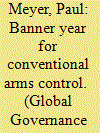

|
|
|
|
|
| Publication |
2014.
|
| Summary/Abstract |
THE CONTROL OF CONVENTIONAL ARMS HAS OFTEN SEEMED THE POOR COUSIN of the global efforts to control weapons of mass destruction (WMD). Since the advent of the atomic era, the focus of arms control and disarmament activity has been overwhelmingly on nuclear weapons and their lesser, if still ugly, stepsisters of biological and chemical weapons. The initial multilateral arms control agreements concerned themselves with limits on the testing of nuclear weapons and, shortly thereafter, with their nonproliferation (e.g., the Nuclear Nonproliferation Treaty of 1968). Bilateral US-Soviet/Russian arms control arrangements also predominantly dealt with the reduction of strategic nuclear forces and restraints on deployments of defenses against (nuclear tipped) ballistic missiles. Efforts to reduce major conventional weapon systems were also taken up in the 1980s in the context of negotiations
between the opposing alliances of NATO and the Warsaw Pact, eventually culminating in the Treaty on Conventional Forces in Europe (CFE Treaty) of 1989. This treaty provided for a massive reduction in the conventional forces that had confronted each other for years in Central Europe and established a new, far more stable security order on the continent. Even the CFE Treaty, however, tended to be overshadowed by other major disarmament agreements concluded in those heady post-Cold War days: the Intermediate Nuclear Forces Treaty (1987), Chemical Weapons Convention (1993), Comprehensive (Nuclear) Test Ban Treaty (1996), and various US-Russian bilateral strategic nuclear arms accords of the 1990s and early 2000s (e.g., the Strategic Arms Reduction Treaty and the Strategic Offensive Reductions Treaty).
|
|
|
|
|
|
|
|
|
|
|
|
|
|
|
|
| 2 |
ID:
128097
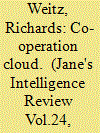

|
|
|
|
|
| Publication |
2012.
|
| Summary/Abstract |
Russia's announcement that it does not want to renew the co-operative threat reducing programme with the United States has raised questions about the bilateral relationship. Richard Weitz investigates what it means for future agreements.
|
|
|
|
|
|
|
|
|
|
|
|
|
|
|
|
| 3 |
ID:
128074
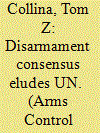

|
|
|
|
|
| Publication |
2013.
|
| Summary/Abstract |
As they complete their annual debate on disarmament and international security, the member states of the United Nations continue to struggle to agree on where to focus their efforts. The next logical step for many, a global ban on the production of fissile materials for nuclear weapons, has been effectively blocked by Pakistan.
Meanwhile, international support is growing to move directly to the elimination of nuclear weapons, which the declared nuclear powers oppose.
|
|
|
|
|
|
|
|
|
|
|
|
|
|
|
|
| 4 |
ID:
130263
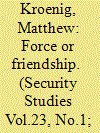

|
|
|
|
|
| Publication |
2014.
|
| Summary/Abstract |
Why do great powers take such different approaches to the issue of nuclear proliferation? Why do states oppose nuclear proliferation more vigorously in some cases than in others? In short, what explains great power nonproliferation policy? To answer these questions, this article tests two competing theories of nonproliferation policy. The first, political relationship theory, suggests that states oppose nuclear proliferation to their enemies but are less concerned when friends acquire nuclear weapons. The second, power-projection theory, argues that states oppose the spread of nuclear weapons to states over which they have the ability to project military power because nuclear proliferation in those situations would constrain their military freedom of action. In contrast, states will be less likely to resist, and more likely to promote, nuclear proliferation to states against which they cannot use force. To test these hypotheses, this article uses evidence from great power nonproliferation policy from 1945 to 2000. While both theories find some support, the power-projection theory performs significantly better. The findings of this article have important implications for international relations theory and US nonproliferation policy.
|
|
|
|
|
|
|
|
|
|
|
|
|
|
|
|
| 5 |
ID:
129109
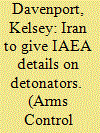

|
|
|
|
|
| Publication |
2014.
|
| Summary/Abstract |
Iran will provide the International Atomic Energy Agency (IAEA) with information about its past development of a detonator that could be used to as a trigger in nuclear weapons, according to an agreement reached by the two sides last month. In a Feb. 9 joint statement, Iran and the IAEA described the two days of talks in Tehran as "constructive" and announced seven actions for Iran to take by May 15 to further the agency's investigations into its unresolved concerns about Iran's current nuclear program and past actions. One of the actions requires Tehran to provide the IAEA with information on exploding bridge wire detonators, which can be used to trigger nuclear weapons. They can also be used in civilian applications, including drilling for oil and gas, and for conventional military explosives.
|
|
|
|
|
|
|
|
|
|
|
|
|
|
|
|
| 6 |
ID:
130360
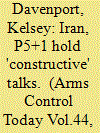

|
|
|
|
|
| Publication |
2014.
|
| Summary/Abstract |
Iran and six world powers held "constructive and useful" talks on a comprehensive deal on Iran's nuclear program, according to a March 19 joint statement released by the parties. A main topic of the talks between Iran and the six-country group, known as the P5+1 (China, France, Germany, Russia, the United Kingdom, and the United States), was Iran's uranium-enrichment program. The March 17-19 talks in Vienna were the second set of meetings between Iran and the P5+1 on a comprehensive deal on Iran's nuclear program after the parties reached an interim agreement in November. Implementation of the initial actions began Jan. 20 and is to last six months. If an agreement is not reached, the interim deal can be extended by mutual consent of the two sides. U.S. officials have said they hope to reach a final deal within the first six months. Iran maintains that its nuclear program is for peaceful purposes, but some countries are concerned that Iran could use its nuclear capabilities to develop nuclear weapons.
|
|
|
|
|
|
|
|
|
|
|
|
|
|
|
|
| 7 |
ID:
129119
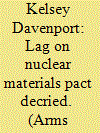

|
|
|
|
|
| Publication |
2014.
|
| Summary/Abstract |
The failure of several key states to ratify a nuclear security treaty ahead of this month's nuclear security summit is a disappointment, but an Indonesian initiative may increase the pace of ratifications, an official familiar with the preparations for the meeting said. The two previous nuclear security summits, in Washington in 2010 and Seoul in 2012, have emphasized the importance of the entry into force of a 2005 amendment to the Convention on the Physical Protection of Nuclear Material (CPPNM). The March 24-25 summit in The Hague is also likely to encourage ratification of this treaty. The original treaty, which entered into force in 1987, sets security standards for nuclear material in transit. Its 2005 amendment would expand the scope of the physical protection measures to cover material in storage. An additional 26 ratifications are necessary to reach the 98 necessary for bringing the amendment into force. Although the 2012 Seoul summit communiqué urged states "in a position to do so to accelerate their domestic approval" of the amendment in order to achieve entry into force by 2014, 17 of the 53 summit participants have yet to ratify it
|
|
|
|
|
|
|
|
|
|
|
|
|
|
|
|
| 8 |
ID:
129126
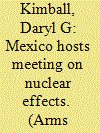

|
|
|
|
|
| Publication |
2014.
|
| Summary/Abstract |
For the second time in two years, diplomats and civil society representatives gathered last month for a two-day conference on the medical and societal impacts of nuclear weapons use, with many governments calling for "new international standards and norms, through a legally binding instrument," according to the chair's summary of the meeting. The agenda of the Feb. 13-14 conference in Nayarit, Mexico, included several presentations from survivors of the Hiroshima and Nagasaki bombings and from experts on the effects of and responses to single nuclear detonations and large-scale nuclear attacks. "It is a fact that no State or international organization has the capacity to address or provide the short- and long-term humanitarian assistance and protection needed in case of a nuclear weapon explosion," concluded Juan Gómez Robledo, conference chair and undersecretary for multilateral affairs and human rights in the Mexican Foreign Ministry. The Nayarit gathering brought together 146 government representatives-more than the 127 that met in Oslo, Norway, in March 2013 for the first such conference.
|
|
|
|
|
|
|
|
|
|
|
|
|
|
|
|
| 9 |
ID:
130017
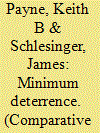

|
|
|
|
|
| Publication |
2014.
|
| Summary/Abstract |
Minimum Deterrence proposals claim that a relatively small number of nuclear weapons, measured in single digits to hundreds, is an adequate nuclear force for all pertinent U.S. deterrence missions, including extending U.S. nuclear deterrence coverage to U.S. allies. The vulnerability of an adversary's population and economy to nuclear weapons and the assumed high value of these targets to opposing leaders is the basis for the confident claims of Minimum Deterrence proponents that U.S. deterrence requirements can be met with a small number of nuclear weapons.
Contemporary proponents of Minimum Deterrence often argue that reducing to low nuclear force levels would:
1. provide deterrence that is more "stable" and greater safety than otherwise would be the case;
2. facilitate nuclear arms control agreements and successful non-proliferation policies;
3. provide substantial savings in the defense budget; and,
4. help create the conditions necessary for a more peaceful world order and help realize the goal of eliminating nuclear weapons entirely, i.e., "nuclear zero."
Recently, some U.S. officials and serving military officers have openly expressed support for the basic points and recommendations of Minimum Deterrence. Given the increased visibility of Minimum Deterrence and its potential to shape forthcoming U.S. policy decisions, it is important to identify the fundamental assumptions, logic and related conclusions of Minimum Deterrence proposals, and determine whether they are sound and consistent with available empirical evidence.
Minimum Deterrence claims generally are predicated on the following series of eight interrelated propositions:
v Deterrence will function reliably and predictably at low U.S. nuclear force numbers, now and in the future. U.S. conventional forces can substitute in many cases for nuclear forces to meet U.S. deterrence goals.
v Nuclear deterrence considerations no longer are pertinent to U.S. relations with Russia and China.
v Nuclear weapons are irrelevant to today's most pressing security threat-weapons of mass destruction (WMD) terrorism.
v Deterrence considerations alone determine the size and composition of the nuclear force requirements.
v Ballistic missile submarines (SSBNs) will remain invulnerable for 30 to 50 years. So, a small SSBN fleet can provide most or all of the nuclear capability needed for U.S. deterrence needs, now and in the future.
v The number of nuclear weapons and the risk of accidents and crises are directly correlated (more nuclear weapons means increased risk, while a decrease in their number reduces the risk).
v U.S. nuclear force reductions are essential to, and will strengthen, nonproliferation efforts; reductions also will facilitate further arms control progress. The Nuclear Non-Proliferation Treaty (NPT) requires U.S. movement toward nuclear disarmament.
v A small number of nuclear weapons is adequate for deterrence; thus U.S. defense spending can be reduced considerably by reducing nuclear forces.
Not all proposals for Minimum Deterrence include each of the eight elements. Several are of more recent vintage. But, a systematic examination reveals that these elements, implicitly or explicitly, are part of the contemporary Minimum Deterrence narrative.
The Obama administration's expressed policy positions undergirding its initiatives for nuclear reductions implicitly or explicitly reflect some, but not allof these eight Minimum Deterrence points. Particularly apparent in this regard is the presumed ability to predict with confidence and precision how deterrence and extended deterrence will work at much lower U.S. nuclear force levels.
Each of these eight points is described and critically examined here.
|
|
|
|
|
|
|
|
|
|
|
|
|
|
|
|
| 10 |
ID:
129133
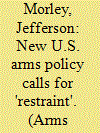

|
|
|
|
|
| Publication |
2014.
|
| Summary/Abstract |
The Obama administration in January announced a new policy on conventional arms transfers that emphasizes the need for restraint in considering transfers that might endanger regional security or human rights. President Barack Obama declared in a Jan. 15 directive that the new policy "supports transfers that meet legitimate security requirements of our allies and partners in support of our national security and foreign policy interests" and "promotes restraint" in those "that may be destabilizing or dangerous to international peace and security." The policy, which replaces a 1995 directive issued by President Bill Clinton, follows the administration's announcement last October that it was loosening rules on the sale of U.S.-made weapons overseas. The reforms announced last fall are part of an effort that the administration says will tighten controls on the sale of the most dangerous arms while enhancing commerce in defense material and services that are not threatening.
|
|
|
|
|
|
|
|
|
|
|
|
|
|
|
|
| 11 |
ID:
129669


|
|
|
|
|
| Publication |
2014.
|
| Summary/Abstract |
Tactical nuclear weapons have emerged as an unavoidable issue for future nuclear weapons negotiations between Russia and the United States. This article discusses challenges and opportunities regarding a tactical nuclear weapons treaty. It begins with an overview of precedents from the 1987 Intermediate Nuclear Forces Treaty and the 1991 Presidential Nuclear Initiatives. These and subsequent experiences show three major obstacles that must be overcome to permit bi-lateral agreement on tactical nuclear weapons: definitional issues over differentiating tactical from strategic nuclear weapons; negotiation challenges including the asymmetries between American and Russian tactical arsenals and non-nuclear capabilities such as ballistic missile defence and conventional prompt global strike; and verification questions over whether and how warhead status can be verified without disclosing sensitive information. This analysis examines whether the International Atomic Energy Agency could have a role in verification to help facilitate agreement. Lastly, this article offers various confidence building measures, emphasizing areas where the two countries could cooperate. While the obstacles are serious, there are opportunities for achieving consensus on some contentious issues.
|
|
|
|
|
|
|
|
|
|
|
|
|
|
|
|
| 12 |
ID:
130225
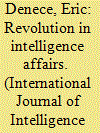

|
|
|
|
|
| Publication |
2014.
|
| Summary/Abstract |
That a "Revolution in Military Affairs" (RMA) took place in the early 1990s is widely known. The concept was born of technological, political, social, and economic changes that were to fundamentally alter the future of warfare, introducing a completely new type of military and organizational structure for the effective projection of force.
Though most experts accepted the reality of a fundamental transformation in the practice of warfare, few saw that a parallel revolution was occurring in the intelligence world, even though this specific field of national security was undergoing similar challenges and change.
That a "Revolution in Intelligence Affairs" in the 1990s and early 2000s actually occurred and its effects has become increasingly evident. This "intelligence revolution" resulted from a combination of changes in international politics, information technologies, and socio-political context.
|
|
|
|
|
|
|
|
|
|
|
|
|
|
|
|
| 13 |
ID:
128062
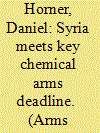

|
|
|
|
|
| Publication |
2013.
|
| Summary/Abstract |
Syria last month met one of the major deadlines for destroying its chemical arms program by "rendering…inoperable" its facilities for producing chemical weapons and for readying the weapons for use, the Organisation for the Prohibition of Chemical Weapons (OPCW) said Oct. 31. Under a plan issued by the OPCW Executive Council and endorsed by the UN Security Council in late September, Syria was to complete "the destruction of chemical weapons production and mixing/filling equipment" by Nov. 1. Mixing and filling equipment is used to load chemical agents into munitions. Government officials and independent experts welcomed the news, but added notes of caution. U.S. Secretary of State John Kerry praised the OPCW-UN team that is overseeing and verifying the Syrian chemical disarmament effort for "work[ing] with unprecedented speed to accomplish the first milestone in eliminating Syria's chemical weapons and reducing the possibility that they will ever be used again." He emphasized that Syria must continue to comply with its obligations under the OPCW Executive Council and UN Security Council decisions.
|
|
|
|
|
|
|
|
|
|
|
|
|
|
|
|
| 14 |
ID:
129110
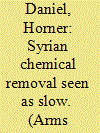

|
|
|
|
|
| Publication |
2014.
|
| Summary/Abstract |
Amid increasing frustration over the pace of Syria's removal of chemical weapons materials for overseas destruction, Syrian authorities are in talks with key countries and experts from the Organisation for the Prohibition of Chemical Weapons (OPCW) and the United Nations on a revised timetable for the removal effort, according to media reports and spokesmen for some of the parties in the negotiations. Syria has proposed a timetable that would take until about the end of May, but the U.S. government "believes that the Syrians are more than capable of moving these chemicals to Latakia on a shorter timetable," a State Department spokesman said in a Feb. 28 e-mail to Arms Control Today. Latakia is the port city in northwestern Syria where the Syrian government is collecting the chemicals from across the country before sending them overseas for destruction.
|
|
|
|
|
|
|
|
|
|
|
|
|
|
|
|
| 15 |
ID:
129131
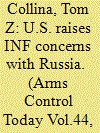

|
|
|
|
|
| Publication |
2014.
|
| Summary/Abstract |
The U.S. State Department confirmed in January that Russia may have breached a landmark arms control agreement by testing a new cruise missile, but has not concluded that Russia violated the accord.
Confirming the details of a Jan. 29 report in The New York Times, State Department spokeswoman Jen Psaki said at a Jan. 30 press briefing that the United States has raised the "possibility of…a violation" with Russia and U.S. NATO allies. The specific U.S. allegation is that Moscow flight-tested a new medium-range, land-based cruise missile. Such a test would run afoul of the 1987 Intermediate-Range Nuclear Forces (INF) Treaty, which permanently bans ground-launched ballistic or cruise missiles capable of traveling 500 to 5,500 kilometers. Rose Gottemoeller, acting undersecretary of state for arms control and international security, has discussed the issue with her Russian and NATO counterparts, Psaki said, adding that "there's still an ongoing review, an interagency review, determining if there was a violation." Psaki indicated that the administration does not view the INF Treaty as being in serious jeopardy.
|
|
|
|
|
|
|
|
|
|
|
|
|
|
|
|
| 16 |
ID:
130326
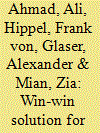

|
|
|
|
|
| Publication |
2014.
|
| Summary/Abstract |
In November 2013, Iran and the P5+1 group of countries (China, France, Germany, Russia, the United Kingdom, and the United States) agreed on a six-month Joint Plan of Action to enable negotiations on a final settlement to contain the proliferation risks from Iran's nuclear program. This interim agreement freezes Iran's enrichment capacity, thereby preventing a further shortening of the time Iran would require to produce weapons quantities of highly enriched uranium (HEU) if it wished.1 This enrichment capacity has expanded greatly over the years since it first came to international attention in 2002. Iran and the P5+1 also have agreed on the need to constrain Iran's option to produce plutonium for weapons using the reactor that is under construction near the city of Arak and that will be under International Atomic Energy Agency (IAEA) safeguards. Under the Joint Plan of Action, Iran has agreed to freeze the Arak reactor project for six months.2 It also has committed not to separate plutonium from spent nuclear fuel or construct a facility capable of doing so. These are important interim commitments. According to Ali Akbar Salehi, the head of the Atomic Energy Organization of Iran, the Arak reactor is intended for radioisotope production and testing of nuclear fuel and materials. In response to the P5+1 proposal that Iran scrap the Arak reactor project, Salehi stated that "we see no point stopping the work on this reactor." He has acknowledged, however, the international community's concerns about the Arak reactor and offered the possibility of design changes "in order to produce less plutonium in this reactor and in this way allay the worries and mitigate the concerns.
|
|
|
|
|
|
|
|
|
|
|
|
|
|
|
|
|
|
|
|
|